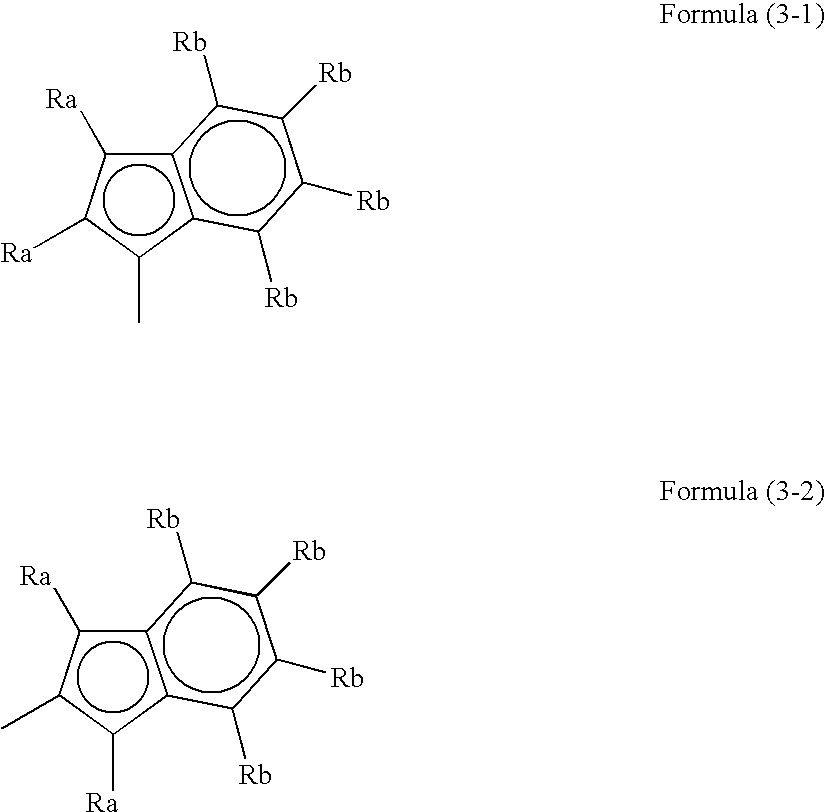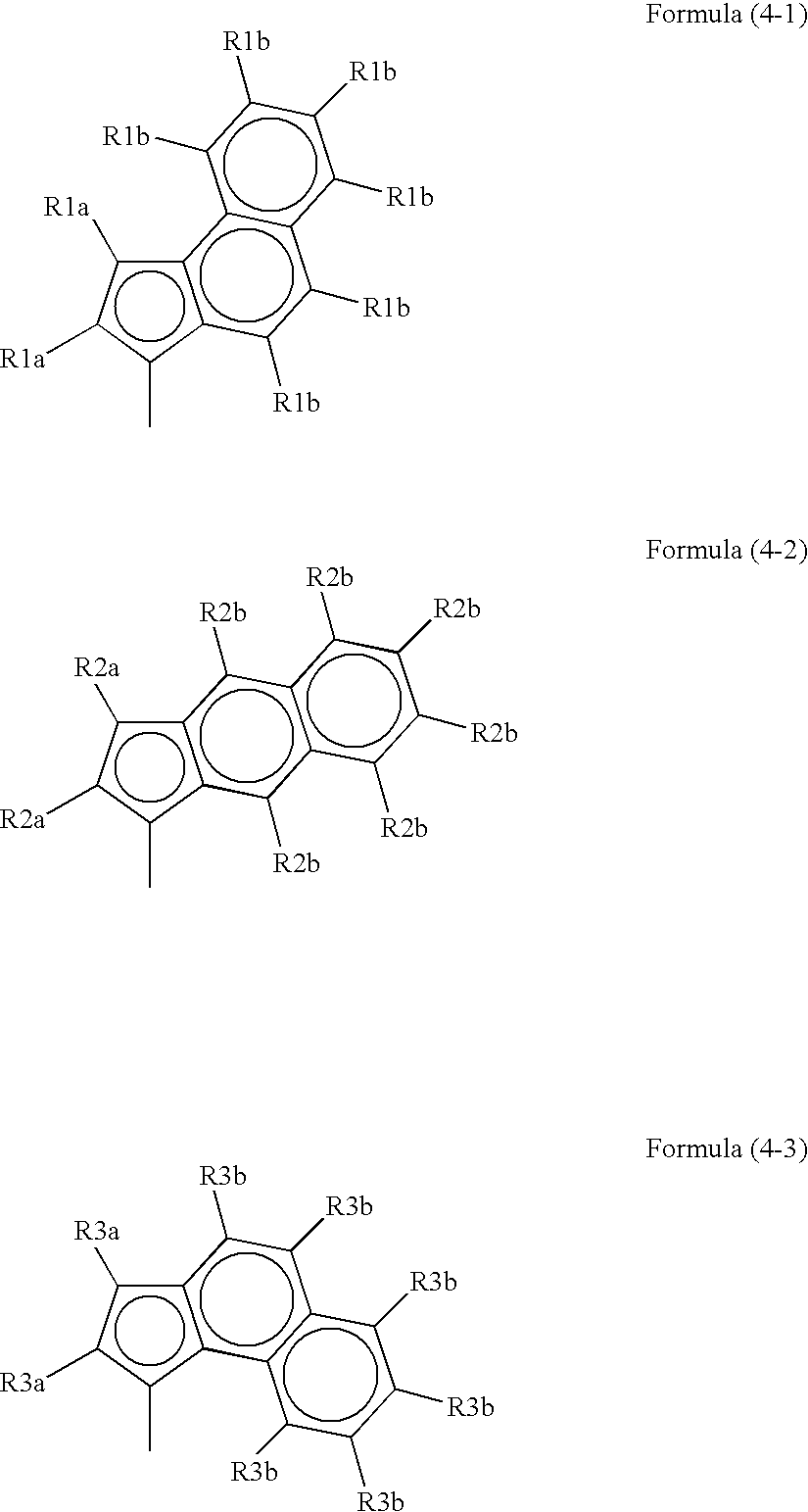Process for producing polymer
a technology of olefin and polymer, which is applied in the field of process for producing olefin polymers, can solve the problems of poor practical applicability, high cost, and low molecular weight of the obtainable polymer
- Summary
- Abstract
- Description
- Claims
- Application Information
AI Technical Summary
Benefits of technology
Problems solved by technology
Method used
Image
Examples
reference example 1
Preparation of Complex
[0098]rac-Phenylboranediylbis{1-(2-methyl-cyclopenta[1]phenanthryl)}zirconium dichloride, another name: rac-phenylborylbis{1-(2-methyl-cyclopenta[1]phenanthryl)}zirconium dichloride, was prepared by the following method.
[0099]
[0100]1H-2-methyl-cyclopenta[1]phenanthrene was prepared by a known method such as one in Organometallics, 16, 3413 (1997).
[0101]rac-Phenylboranediylbis{1-(2-methyl-cyclopenta[1]phenanthryl)}zirconium dichloride was prepared as follows.
Preparation of Ligand
[0102]The ligand was prepared with reference to a synthesis of rac-phenylboranediylbis(1-indenyl)zirconium dichloride as disclosed in U.S. Pat. No. 5,962,718, provided that the indene used was changed to 1H-(2-methyl-cyclopenta[1]phenanthrene).
[0103]Namely, under an argon stream, 50 ml of a diethyl ether solution of 5.0 g (21.7 mmol) of 1H-(2-methyl-cyclopenta[1]phenanthrene) was cooled to 0° C., and then, a n-butyllithium / hexane solution (21.7 mmol as butyl lithium) was added and stirre...
reference example 2
Preparation of Complex
[0108]Diisopropylaminoboranediylbis(2-methyl-4,5-benzo-1-indenyl)zirconium dichloride (another name: diisopropylamidoboranebis(2-methyl-4,5-benzo-1-indenyl)zirconium dichloride) was prepared as follows.
[0109]
[0110]2-Methyl-4,5-benzoindene{1-H or 3-H-2-methylbenzo(e)indene} was prepared by a known method.
[0111]It was prepared with reference to the synthesis of rac-diisopropylaminoboranediylbis(1-indenyl)zirconium dichloride as disclosed in Organometallics 1999, 18, 2288, provided that the indene used was changed to 2-methyl-4,5-benzoindene.
[0112]The obtained complex was yellow crystals and showed peaks at the following positions in the 1H-NMR measured by using TMS as a standard and CDCl3 as a solvent. δ1.56 ppm (d, 6H), 1.58 ppm (d, 6H), 2.28 ppm (s, 6H), 4.33 ppm (Hept, 2H), 7.17–7.98 (many peaks, 14H).
reference example 3
Preparation of Complex
[0113]rac-Diisopropylaminoboranediylbis(4,5-benzo-1-indenyl)zirconium dichloride (another name: rac-diisopropylamidoboranebis(4,5-benzo-1-indenyl)zirconium dichloride) was prepared by the following method.
[0114]
[0115]4,5-benzoindene was prepared by a known method.
[0116]The rac-diisopropylaminoboranediylbis(4,5-benzo-1-indenyl)zirconium dichloride was prepared with reference to the synthesis of rac-diisopropylaminoboranediylbis(1-indenyl)zirconium dichloride as disclosed in Organometallics 1999, 18, 2288, provided that the indene used was changed to 4,5-benzoindene.
[0117]The obtained complex showed peaks at the following positions in the 1H-NMR measured by using TMS as a standard and CDCl3 as a solvent. δ1.50 ppm (d, 6H), 1.56 ppm (d, 6H), 4.23 (Hept, 2H), 5.89 (d, 2H) 6.99–8.04 (many peaks, 14H)
PUM
| Property | Measurement | Unit |
|---|---|---|
| molar ratio | aaaaa | aaaaa |
| temperature | aaaaa | aaaaa |
| temperature | aaaaa | aaaaa |
Abstract
Description
Claims
Application Information
 Login to View More
Login to View More - R&D
- Intellectual Property
- Life Sciences
- Materials
- Tech Scout
- Unparalleled Data Quality
- Higher Quality Content
- 60% Fewer Hallucinations
Browse by: Latest US Patents, China's latest patents, Technical Efficacy Thesaurus, Application Domain, Technology Topic, Popular Technical Reports.
© 2025 PatSnap. All rights reserved.Legal|Privacy policy|Modern Slavery Act Transparency Statement|Sitemap|About US| Contact US: help@patsnap.com



